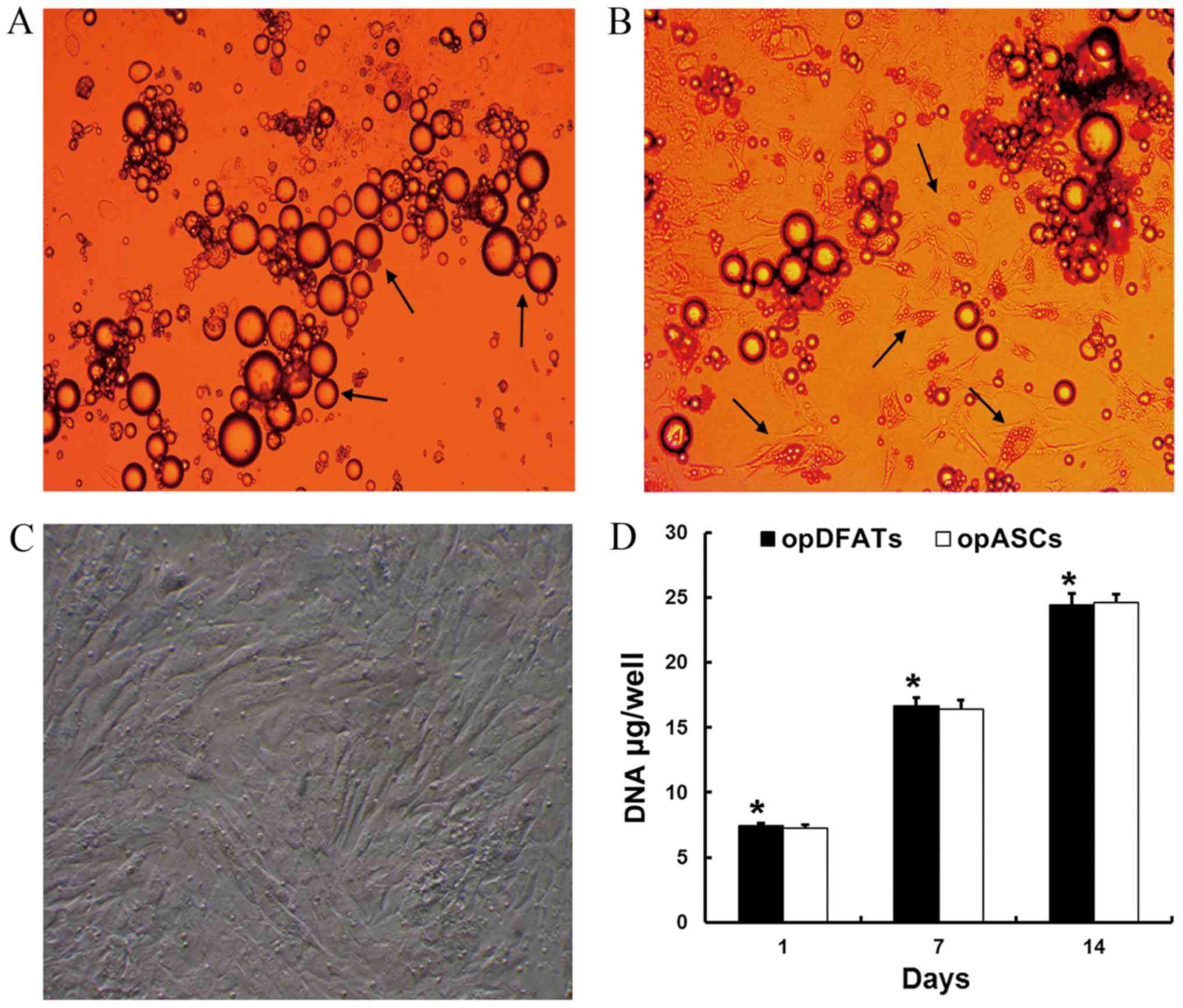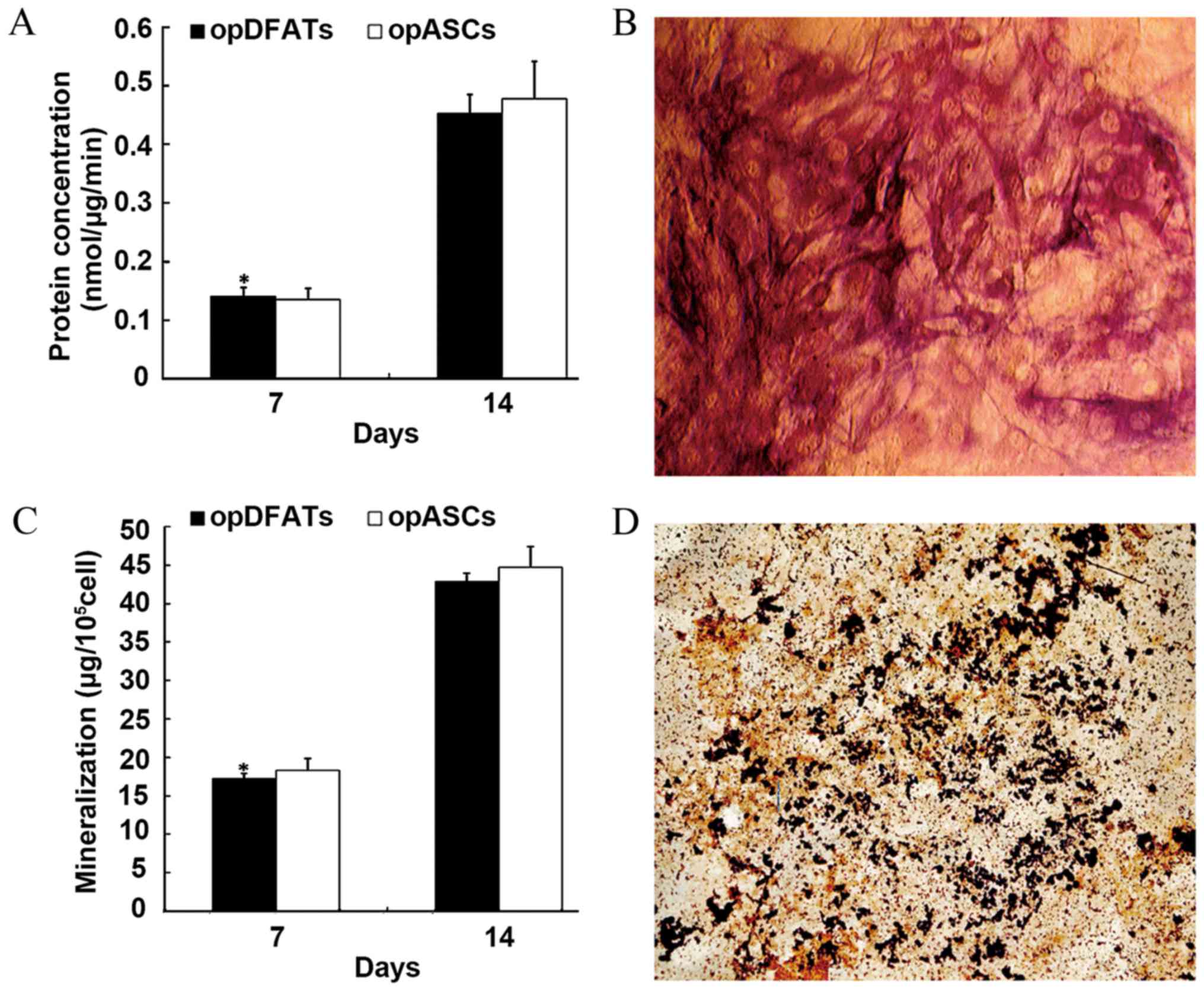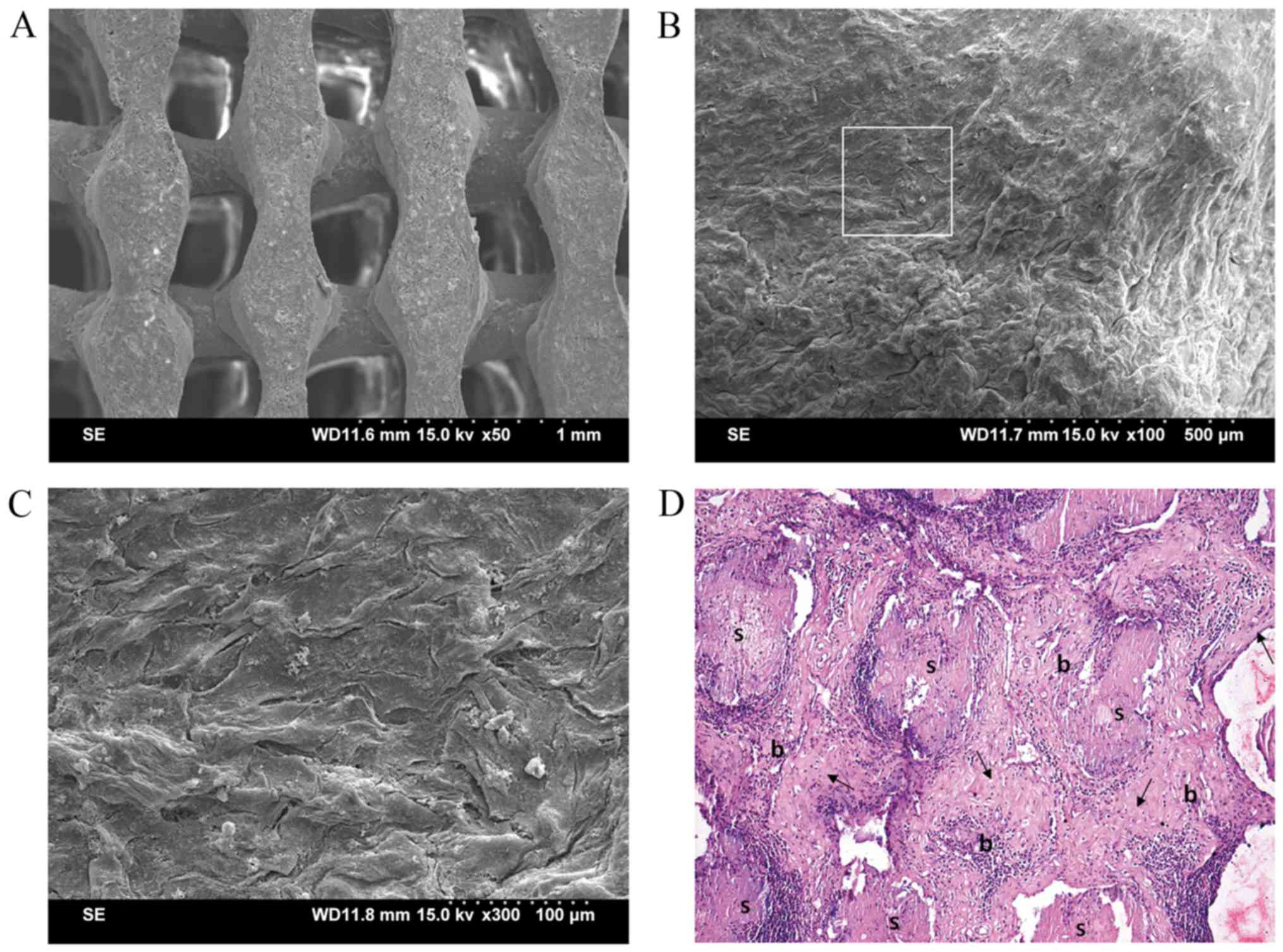|
1
|
Jiang M, Wang X, Liu H, Zhou L, Jiang T,
Zhou H and Hao W: Bone formation in adipose-derived stem cells
isolated from elderly patients with osteoporosis: A preliminary
study. Cell Biol Int. 38:97–105. 2014. View Article : Google Scholar : PubMed/NCBI
|
|
2
|
Hao W, Hu YY, Wei YY, Pang L, Lv R, Bai
JP, Xiong Z and Jiang M: Collagen I gel can facilitate homogenous
bone formation of adipose-derived stem cells in PLGA-beta-TCP
scaffold. Cells Tissues Organs. 187:89–102. 2008. View Article : Google Scholar : PubMed/NCBI
|
|
3
|
Lee JH, Lee JH, Park JW and Shin YH: The
insertional torque of a pedicle screw has a positive correlation
with bone mineral density in posterior lumbar pedicle screw
fixation. J Bone Joint Surg Br. 94:93–97. 2012. View Article : Google Scholar : PubMed/NCBI
|
|
4
|
Wu ZX, Gong FT, Liu L, Ma ZS, Zhang Y,
Zhao X, Yang M, Lei W and Sang HX: A comparative study on screw
loosening in osteoporotic lumbar spine fusion between expandable
and conventional pedicle screws. Arch Orthop Trauma Surg.
132:471–476. 2012. View Article : Google Scholar : PubMed/NCBI
|
|
5
|
Hao W, Pang L, Jiang M, Lv R, Xiong Z and
Hu YY: Skeletal repair in rabbits using a novel biomimetic
composite based on adipose-derived stem cells encapsulated in
collagen I gel with PLGA-beta-TCP scaffold. J Orthop Res.
28:252–257. 2010.PubMed/NCBI
|
|
6
|
Hao W, Dong J, Jiang M, Wu J, Cui F and
Zhou D: Enhanced bone formation in large segmental radial defects
by combining adipose-derived stem cells expressing bone
morphogenetic protein 2 with nHA/RHLC/PLA scaffold. Int Orthop.
34:1341–1349. 2010. View Article : Google Scholar : PubMed/NCBI
|
|
7
|
Rosen CJ and Bouxsein ML: Mechanisms of
disease: Is osteoporosis the obesity of bone? Nat Clin Pract
Rheumatol. 2:35–43. 2006. View Article : Google Scholar : PubMed/NCBI
|
|
8
|
Hagey AR and Warren MP: Role of exercise
and nutrition in menopause. Clin Obstet Gynecol. 51:627–641. 2008.
View Article : Google Scholar : PubMed/NCBI
|
|
9
|
Carbonare L Dalle, Valenti MT, Zanatta M,
Donatelli L and Lo Cascio V: Circulating mesenchymal stem cells
with abnormal osteogenic differentiation in patients with
osteoporosis. Arthritis Rheum. 60:3356–3365. 2009. View Article : Google Scholar : PubMed/NCBI
|
|
10
|
Chen JR, Lazarenko OP, Wu X, Tong Y,
Blackburn ML, Shankar K, Badger TM and Ronis MJ: Obesity reduces
bone density associated with activation of PPARγ and suppression of
Wnt/β-catenin in rapidly growing male rats. PLoS One. 5:e137042010.
View Article : Google Scholar : PubMed/NCBI
|
|
11
|
Chen HT, Lee MJ, Chen CH, Chuang SC, Chang
LF, Ho ML, Hung SH, Fu YC, Wang YH, Wang HI, et al: Proliferation
and differentiation potential of human adipose-derived mesenchymal
stem cells isolated from elderly patients with osteoporotic
fractures. J Cell Mol Med. 16:582–593. 2012. View Article : Google Scholar : PubMed/NCBI
|
|
12
|
Wu W, Niklason L and Steinbacher DM: The
effect of age on human adipose-derived stem cells. Plast Reconstr
Surg. 131:27–37. 2013. View Article : Google Scholar : PubMed/NCBI
|
|
13
|
Park SR, Oreffo RO and Triffitt JT:
Interconversion potential of cloned human marrow adipocytes in
vitro. Bone. 24:549–554. 1999. View Article : Google Scholar : PubMed/NCBI
|
|
14
|
Justesen J, Pedersen SB, Stenderup K and
Kassem M: Subcutaneous adipocytes can differentiate into
bone-forming cells in vitro and in vivo. Tissue Eng. 10:381–391.
2004. View Article : Google Scholar : PubMed/NCBI
|
|
15
|
Poloni A, Maurizi G, Leoni P, Serrani F,
Mancini S, Frontini A, Zingaretti MC, Siquini W, Sarzani R and
Cinti S: Human dedifferentiated adipocytes show similar properties
to bone marrow-derived mesenchymal stem cells. Stem Cells.
30:965–974. 2012. View Article : Google Scholar : PubMed/NCBI
|
|
16
|
Kikuta S, Tanaka N, Kazama T, Kazama M,
Kano K, Ryu J, Tokuhashi Y and Matsumoto T: Osteogenic effects of
dedifferentiated fat cell transplantation in rabbit models of bone
defect and ovariectomy-induced osteoporosis. Tissue Eng Part A.
19:1792–1802. 2013. View Article : Google Scholar : PubMed/NCBI
|
|
17
|
Hodson AW and Skillen AW: Comparison of
diazo-coupling, formazan, and silver staining techniques for
visualizing alkaline phosphatase isoenzymes after electrophoresis
in homogeneous-pore and gradient-pore polyacrylamide gels. Anal
Biochem. 169:253–261. 1988. View Article : Google Scholar : PubMed/NCBI
|
|
18
|
Mallory FB: Pathological techniques: A
practical manual for workers in pathological histology including
directions for the performance of autopsies and for
microphotography. WB Saunders, Philadelphia, PA; pp. 143–144.
1983
|
|
19
|
Stolzing A, Jones E, McGonagle D and Scutt
A: Age-related changes in human bone marrow-derived mesenchymal
stem cells: Consequences for cell therapies. Mech Ageing Dev.
129:163–173. 2008. View Article : Google Scholar : PubMed/NCBI
|
|
20
|
Zhou S, Greenberger JS, Epperly MW, Goff
JP, Adler C, Leboff MS and Glowacki J: Age-related intrinsic
changes in human bone-marrow-derived mesenchymal stem cells and
their differentiation to osteoblasts. Aging cell. 7:335–343. 2008.
View Article : Google Scholar : PubMed/NCBI
|
|
21
|
Riis BJ, Rødbro P and Christiansen C: The
role of serum concentrations of sex steroids and bone turnover in
the development and occurrence of postmenopausal osteoporosis.
Calcif Tissue Int. 38:318–322. 1986. View Article : Google Scholar : PubMed/NCBI
|
|
22
|
Lau EM, Chan YH, Chan M, Woo J, Griffith
J, Chan HH and Leung PC: Vertebral deformity in chinese men:
Prevalence, risk factors, bone mineral density, and body
composition measurements. Calcif Tissue Int. 66:47–52. 2000.
View Article : Google Scholar : PubMed/NCBI
|
|
23
|
Hsu YH, Venners SA, Terwedow HA, Feng Y,
Niu T, Li Z, Laird N, Brain JD, Cummings SR, Bouxsein ML, et al:
Relation of body composition, fat mass, and serum lipids to
osteoporotic fractures and bone mineral density in Chinese men and
women. Am J Clin Nutr. 83:146–154. 2006.PubMed/NCBI
|
|
24
|
Zhao LJ, Liu YJ, Liu PY, Hamilton J,
Recker RR and Deng HW: Relationship of obesity with osteoporosis. J
Clin Endocrinol Metab. 92:1640–1646. 2007. View Article : Google Scholar : PubMed/NCBI
|
|
25
|
Zhao LJ, Jiang H, Papasian CJ, Maulik D,
Drees B, Hamilton J and Deng HW: Correlation of obesity and
osteoporosis: Effect of fat mass on the determination of
osteoporosis. J Bone Miner Res. 23:17–29. 2008. View Article : Google Scholar : PubMed/NCBI
|
|
26
|
Matsumoto T, Kano K, Kondo D, Fukuda N,
Iribe Y, Tanaka N, Matsubara Y, Sakuma T, Satomi A, Otaki M, et al:
Mature adipocyte-derived dedifferentiated fat cells exhibit
multilineage potential. J Cell Physiol. 215:210–222. 2008.
View Article : Google Scholar : PubMed/NCBI
|
|
27
|
Schäffler A and Büchler C: Concise review:
Adipose tissue-derived stromal cells-basic and clinical
implications for novel cell-based therapies. Stem cells.
25:818–827. 2007. View Article : Google Scholar : PubMed/NCBI
|
|
28
|
Zuk PA, Zhu M, Mizuno H, Huang J, Futrell
JW, Katz AJ, Benhaim P, Lorenz HP and Hedrick MH: Multilineage
cells from human adipose tissue: Implications for cell-based
therapies. Tissue Eng. 7:211–228. 2001. View Article : Google Scholar : PubMed/NCBI
|
|
29
|
Yoshimura K, Shigeura T, Matsumoto D, Sato
T, Takaki Y, Aiba-Kojima E, Sato K, Inoue K, Nagase T, Koshima I
and Gonda K: Characterization of freshly isolated and cultured
cells derived from the fatty and fluid portions of liposuction
aspirates. J Cell Physiol. 208:64–76. 2006. View Article : Google Scholar : PubMed/NCBI
|
|
30
|
Kazama T, Fujie M, Endo T and Kano K:
Mature adipocyte-derived dedifferentiated fat cells can
transdifferentiate into skeletal myocytes in vitro. Biochem Biophys
Res Commun. 377:780–785. 2008. View Article : Google Scholar : PubMed/NCBI
|
|
31
|
Oki Y, Watanabe S, Endo T and Kano K:
Mature adipocyte-derived dedifferentiated fat cells can
trans-differentiate into osteoblasts in vitro and in vivo only by
all-trans retinoic acid. Cell Struct Funct. 33:211–222. 2008.
View Article : Google Scholar : PubMed/NCBI
|
|
32
|
Jumabay M, Matsumoto T, Yokoyama S, Kano
K, Kusumi Y, Masuko T, Mitsumata M, Saito S, Hirayama A, Mugishima
H and Fukuda N: Dedifferentiated fat cells convert to cardiomyocyte
phenotype and repair infarcted cardiac tissue in rats. J Mol Cell
Cardiol. 47:565–575. 2009. View Article : Google Scholar : PubMed/NCBI
|
|
33
|
Sakuma T, Matsumoto T, Kano K, Fukuda N,
Obinata D, Yamaguchi K, Yoshida T, Takahashi S and Mugishima H:
Mature, adipocyte derived, dedifferentiated fat cells can
differentiate into smooth muscle-like cells and contribute to
bladder tissue regeneration. J Urol. 182:355–365. 2009. View Article : Google Scholar : PubMed/NCBI
|
|
34
|
Nakamura T, Shinohara Y, Momozaki S,
Yoshimoto T and Noguchi K: Co-stimulation with bone morphogenetic
protein-9 and FK506 induces remarkable osteoblastic differentiation
in rat dedifferentiated fat cells. Biochem Biophys Res Commun.
440:289–294. 2013. View Article : Google Scholar : PubMed/NCBI
|
|
35
|
Liu HY, Wu AT, Tsai CY, Chou KR, Zeng R,
Wang MF, Chang WC, Hwang SM, Su CH and Deng WP: The balance between
adipogenesis and osteogenesis in bone regeneration by platelet-rich
plasma for age-related osteoporosis. Biomaterials. 32:6773–6780.
2011. View Article : Google Scholar : PubMed/NCBI
|
|
36
|
Xiong Z, Yan Y, Wang S, Zhang R and Zhang
C: Fabrication of porous scaffolds for bone tissue engineering via
low-temperature deposition. Scripta Materialia. 46:771–776. 2002.
View Article : Google Scholar
|


















